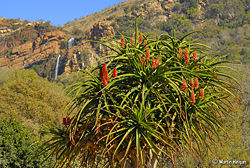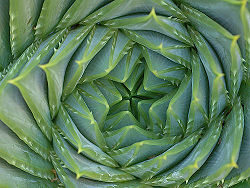Aloe
| Aloe |
|---|

|
| Scientific Classification |
|
| Species |
|
| Aloe polyphylla |
The genus Aloe contains about 400 species. The most commonly known species is Aloe Vera which is very frequently used as medical treatment on skin. [1]. It can be found in semi-tropical regions and is known as a succulent plant which means it can store a lot of water in its roots and leaves. The Aloe plant has been used for many years and can be dated back to biblical times. It is related to members of the Lily family like the onion, garlic, and turnips. Like those plants, Aloe can also be consumed.[2]
Anatomy
An Aloe plant has a large rosette of thick, fresh leaves. It can range in size from 1 inch to a colonel that contains hundreds of plants that are 2 feet in diameter.[3] A single mature Aloe plant can grow to be as tall as 2 1/2 to 4 feet in length.[4] The leaves of an Aloe are lance-shaped and have a sharp apex and a spiny margin. The flowers of the Aloe are yellow, pink, or red and have a tubular shape. All the flowers can be found on simple or branched leafless stems. Most of aloe plants are stemless and grow directly out of the ground. Some other Aloe plants have branched or unbranched stems; in this case the plants freshly leaves grow from the branch. They usually have 12 to 16 leaves that weight 3 pounds.[5] The color of the stem varies from grey or green and stripped or mottled. [6] The reason Aloe is known for being so medically helpful is because of the mucopolysaccharides which can be found in the inner gel part of the Aloe leaf. The part of the plant that is used for medical purposes is the lower leaf of the plant. Once the lower leaf is removed and sliced open, the gel that is gathered can be used for various medicinal purposes. Also, the leaves and seeds of Aloe care the two parts of the plant that can be consumed. Before using the Aloe directly from the plant, be sure to remove the yellow substance and the skin because this part can irritate the skin. The gel that you are about to use should be clear, odorless, and tasteless. [7]
Growing
Most Aloe plants are found in peoples' homes. To take care of an Aloe plant there must be warm weather for them to survive. If they are being planted in a yard then full sun or very little shade is required. The soil that they are planted in must be moderately fertile and be capable of draining quickly. They will be able to survive with no water, but it is beneficial to the plant to provide water. If Aloe is kept as a plant in a pot, it must be kept it indoors during cooler months. Because they are succulent plants they store a lot of water in their roots and leaves. During the winter month it is not necessary to water the plant often, in fact watering should be minimal. During the summer months the water in the pot should be completely drenched. The plant should not be re-watered until the soil is dry. Since Aloe's roots grow shallow when planting, choose a pot that is not too deep and make sure it draining holes at the bottom. It only needs to be re-fertilize every year, in spring. If you would like you can also Aloe grow from a seed.[8]
Ecology
The genus Aloe is found mostly in Africa. It commonly can be found in South Africa's Cape Province and the tropical mountainous areas of Africa. Another place it can be found is Africa's neighbors such as Madagascar, the Arabian Peninsula, and the islands off the coast of Africa. [9] Also they can be found in Mexico, India, Central America, the Caribbean, Australia and the Pacific Rim Countries. They also can be found in Parts of the United States. In the U.S. it can be found in the Rio Grande Valley of the southern part of Texas, Florida and Southern California. [10] Aloes are semitropical plants that need to live in warm areas. They need a lot of light and can only live in places were there is no chance of freezing. They also make very good house plants and not too hard to take care of. [11] Aloes are very often thought of as ornamental plants in pots and gardens. They are also very valued to collectors and decorative plants. [12]
Uses of Aloe
Aloe has been used for a very long time. It has been said that Cleopatra used it to make herself look beautiful. The healing power of Aloe was discovered by the Egyptians. They also would use it when they were embalming. By the 10th Century Aloe arrived in Europe and they began to use it in herbal medicines. Six centuries later it arrived in the West Indies where it is still grown and harvested today. Although there are over 300 different kinds of Aloe only a few are used for medical uses. These include Aloe perryi and Aloe ferox. The Romans and Greeks would use Aloe as treatment for wounds. Now-a-days it is mostly commonly used to relieve skin discomforts such as burns, wounds and skin conditions like ringworm [13] Aloe and athlete’s foot [14]. Once the Aloe gel is applied to the wound the effective is almost instant. It is also is thought to apply a layer of protection of the wound to lower the change of infection. There have also been some studies to see the benefits of Aloe internally. It is thought that it could possible used as treating type II diabetes.[15] A study done in the 1990's showed that the healing time of a burn that were moderate to severe, healed faster with Aloe than in a bandage. However another test showed that a wound with Aloe Vera gel applied to it took longer to heal. Aloe can also be used as a conservative for fresh produce. The gel that is used to preserve the fruit is odorless, tasteless, and colorless. It also is more environmentally friendly and safe compared to sulfur dioxide. Also a lot of cosmetic companies use Aloe in their shampoo, sunscreen, lotion, makeup, and soaps.[16]
Gallery
 Browse |
References
- Aloe Wikipedia.
- Aloe Vera Wikipedia.
- Growing Aloe The Garden Helper.
- The complete story The International Aloe Science Council]





